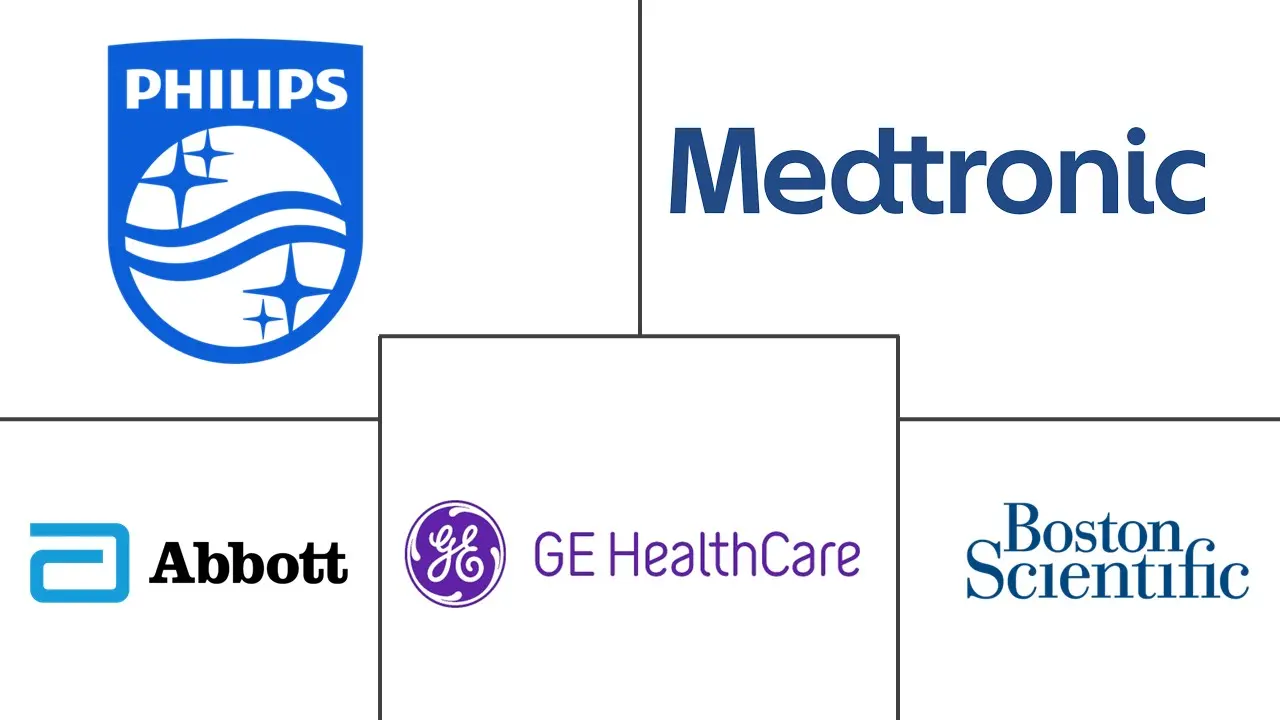Telemonitoring Systems Market Size and Share
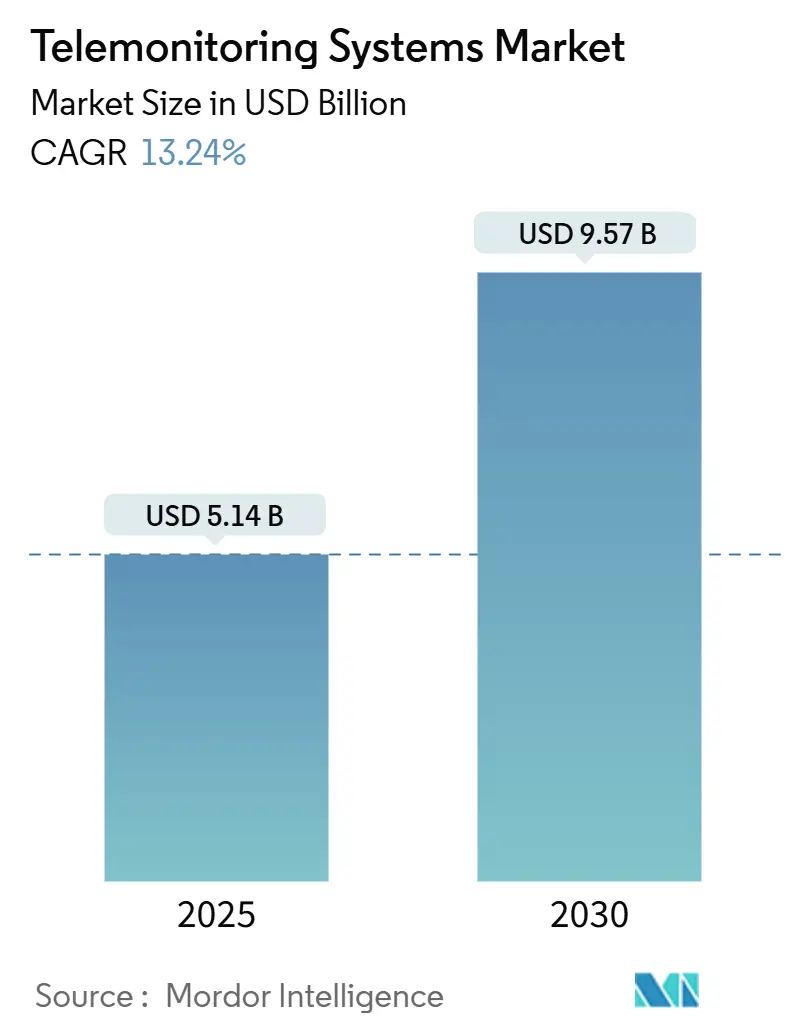
Telemonitoring Systems Market Analysis by Mordor Intelligence
The telemonitoring systems market stands at USD 5.14 billion in 2025 and is forecast to reach USD 9.57 billion by 2030, reflecting a robust 13.24% CAGR. This growth reflects the rapid transition from episodic care to home-based, predictive models that use artificial intelligence (AI) to convert continuous data feeds into real-time clinical guidance.[1]Jonathan Blum, “Lessons from CMS’ Acute Hospital Care at Home Initiative,” Centers for Medicare & Medicaid Services, cms.gov Recent reimbursement changes—most notably the Centers for Medicare & Medicaid Services (CMS) expansion of Remote Patient Monitoring (RPM) and the debut of Advanced Primary Care Management billing codes—have made these systems financially sustainable for providers. AI-equipped cardiac platforms now detect atrial fibrillation weeks earlier than legacy monitors, while consumer-grade continuous glucose monitors (CGMs) are moving beyond diabetes care to wider metabolic-health applications. North America leads adoption thanks to aggressive Hospital-at-Home rollouts, whereas Asia-Pacific emerges as the fastest-growing region on the back of 5G infrastructure and supportive digital-health policies.
Key Report Takeaways
- By product type, cardiac systems led with 31.43% revenue share in 2024; glucose-level systems are projected to expand at a 17.55% CAGR through 2030.
- By component, devices accounted for 82.12% of the telemonitoring systems market share in 2024, while software platforms are forecast to grow at a 15.34% CAGR between 2025-2030.
- By connectivity technology, Bluetooth/Low-Energy held 35.45% share in 2024; cellular networks are expected to post the fastest 16.78% CAGR through 2030.
- By application, cardiovascular monitoring captured 24.56% of the telemonitoring systems market size in 2024, whereas diabetes management is advancing at a 16.32% CAGR to 2030.
- By end-user setting, hospitals and specialty clinics maintained 43.21% share in 2024, while home-care environments are set to rise at a 15.88% CAGR over the forecast period.
- By geography, North America dominated with 39.87% market share in 2024; Asia-Pacific is the fastest-growing region, climbing at a 14.76% CAGR through 2030.
Global Telemonitoring Systems Market Trends and Insights
Drivers Impact Analysis
| Driver | (~) % Impact on CAGR Forecast | Geographic Relevance | Impact Timeline |
|---|---|---|---|
| Growing Chronic Disease Burden & Ageing Population | + 2.8% | Global, with concentration in North America & Europe | Long term (≥ 4 years) |
| Expansion Of Reimbursement Codes For RPM & Telehealth | + 3.1% | North America primary, EU secondary adoption | Medium term (2-4 years) |
| Tech Advances In Wearables & 5G Connectivity | + 2.4% | APAC core, spill-over to North America | Medium term (2-4 years) |
| Pressure To Cut Readmissions & Hospital Costs | + 2.2% | Global, with early gains in US health systems | Short term (≤ 2 years) |
| Capacity-Driven "Hospital-At-Home" Roll-Outs | + 1.9% | North America & EU, pilot expansion to APAC | Medium term (2-4 years) |
| AI-Powered Predictive Analytics Turns RPM Data Into Billable Insight | + 2.6% | Global, with technology hubs leading adoption | Long term (≥ 4 years) |
| Source: Mordor Intelligence | |||
Growing Chronic Disease Burden & Ageing Population
An unprecedented rise in multimorbidity and an aging demographic underpin demand for continuous monitoring far beyond traditional clinical walls. Japan illustrates the challenge: 29% of its citizens are already over 65, spurring nationwide digital-health initiatives that position telemonitoring as a workforce-saving solution. The Japanese Society of Ningen Dock’s endorsement of multi-parameter MCG screening underlines clinician confidence in proactive, tech-enabled chronic-disease management. In rural China, education and income shape willingness to adopt telemedicine, suggesting implementation programs must address socioeconomic hurdles to unlock full population health benefits.[2]Yusi Yin, “Factors Influencing the Adoption of Telemedicine Services Among Middle-Aged and Older Patients With Chronic Conditions in Rural China,” BMC Health Services Research, bmchealthservres.biomedcentral.com Chronic-care telemonitoring, costing roughly USD 10 per patient-day versus USD 500 for a hospital bed, gives providers a compelling economic incentive to scale programs.
Expansion of Reimbursement Codes for RPM & Telehealth
CMS’s 2025 Physician Fee Schedule allows providers to layer Advanced Primary Care Management payments on top of existing RPM codes, boosting revenue per enrolled patient. Permanent coverage for audio-only visits and simplified Federally Qualified Health Center billing expands access in low-resource settings. Yet only a dozen US states reimburse Hospital-at-Home under Medicaid, and EU payment policies vary sharply, with Germany and Belgium far ahead of peers in digital-device integration.[3]Tanguy Renault, “Towards Harmonizing Assessment and Reimbursement of Digital Medical Devices in the EU Through Mutual Learning,” Nature Digital Medicine, nature.comClinicians welcome the American Medical Association’s newly added RPM codes, but still face complex documentation rules that can slow scaling.
Tech Advances in Wearables & 5G Connectivity
Standalone 5G medical networks in China illustrate latency-free data transmission, enabling real-time remote procedures such as the world’s first 5G robotic thyroidectomy spanning 1,200 km. Cellular and NB-IoT links are growing at 16.78% CAGR because they function reliably where Wi-Fi falters, an advantage for rural or mobile patients. Closed-loop CGMs—for example Abbott’s FreeStyle Libre 2 Plus paired with Tandem’s insulin pump—exemplify how wearables feed algorithmic dosing to preempt hypoglycemic events.
Pressure to Cut Readmissions & Hospital Costs
US health systems face Medicare penalties tied to avoidable readmissions, pushing executives toward telemonitoring that flags deterioration early, lowers acute events, and reduces length of stay. Early adopters report savings of USD 1,300-1,550 per patient episode through avoided emergency visits and shorter admissions. In Europe, bundled-payment experiments reveal similar gains, reinforcing the move from volume to outcomes-based contracting.
Restraints Impact Analysis
| Restraint | (~) % Impact on CAGR Forecast | Geographic Relevance | Impact Timeline |
|---|---|---|---|
| Rural ICT & Broadband Gaps | -1.8% | Global, concentrated in rural US, developing regions | Long term (≥ 4 years) |
| Cyber-Security / Privacy Breaches | -1.2% | Global, with heightened concern in EU under GDPR | Medium term (2-4 years) |
| Clinician Workflow Overload From Raw RPM Data | -1.5% | Global, particularly acute in understaffed health systems | Short term (≤ 2 years) |
| Patchy Non-US Reimbursement & Evidence Thresholds | -1.1% | International markets excluding North America | Medium term (2-4 years) |
| Source: Mordor Intelligence | |||
Rural ICT & Broadband Gaps
Roughly 3 million Americans living in broadband “deserts” cannot transmit high-resolution sensor data, limiting telemonitoring reach where chronic-disease rates are often highest. Greene County Health System in Alabama, for instance, operates with speeds a tenth of what electronic health records require, forcing nurses to revert to manual vitals checks. Digital inequities also span device ownership and literacy; only 46% of rural households subscribe to fixed broadband versus 67% of urban peers.
Cyber-Security / Privacy Breaches
Continuous data-flow architecture expands the threat surface. GDPR imposes fines up to 4% of global turnover for breaches, forcing EU providers to invest heavily in encryption and zero-trust frameworks. In North America, ransomware attacks on hospital IoT devices have doubled since 2023, leading to downtime that jeopardizes patient safety and erodes trust.
Segment Analysis
By Product Type: Cardiac Systems Drive Clinical Validation
Cardiac platforms held 31.43% of telemonitoring systems market share in 2024, thanks to well-established reimbursement and FDA-cleared devices such as Abbott’s Assert-IQ, which offers six-year battery life and AI-enhanced arrhythmia detection. Glucose-monitoring devices are projected to expand at 17.55% CAGR, propelled by consumer wellness trends and OTC CGM approvals. This segment’s rise widens the telemonitoring systems market by attracting non-diabetic users keen on metabolic fitness.
Preventive care models are spurring multi-parameter monitors that aggregate ECG, SpO₂, and blood pressure in one wearable, echoing the market’s pivot from single-metric tools to holistic platforms. COPD and hypertension devices fill niche needs but face slower growth until broader clinical guidelines endorse remote management.
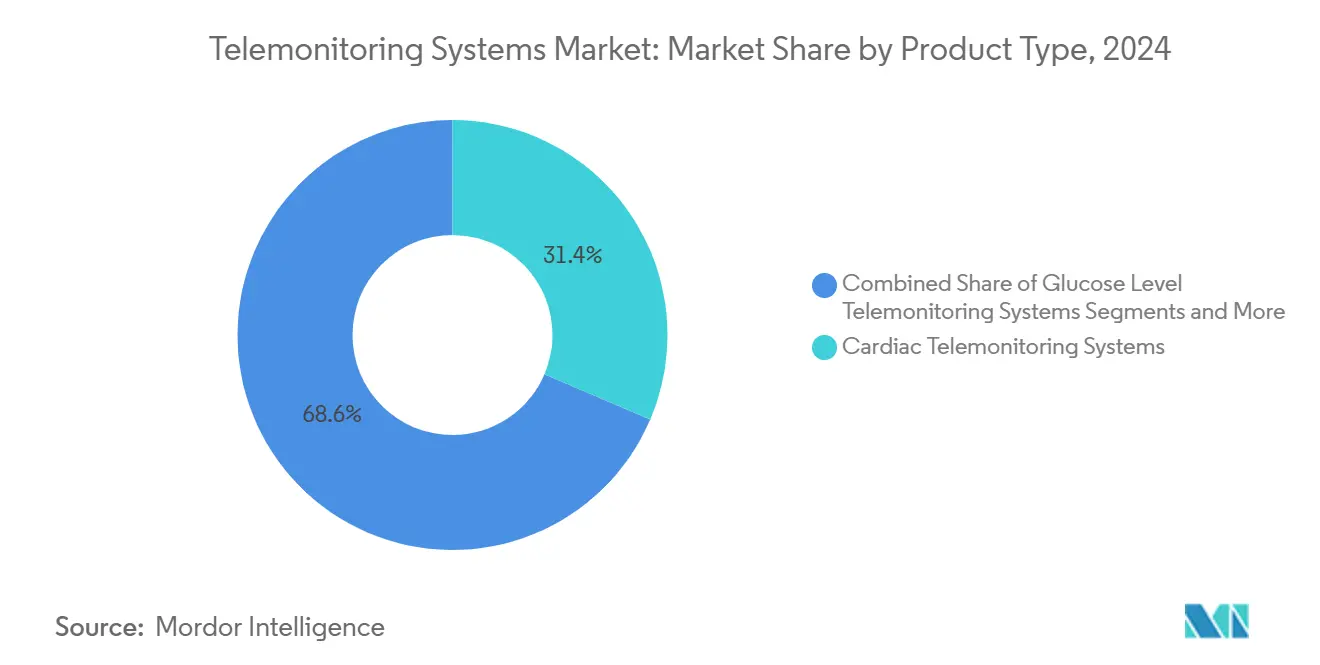
Note: Segment shares of all individual segments available upon report purchase
By Component: Software Platforms Accelerate Integration
Hardware captured 82.12% revenue in 2024, but software is advancing at a 15.34% CAGR, reflecting the industry’s recognition that data unification and algorithmic insights drive value. Philips’ viQtor integration exemplifies software-centric ecosystems that streamline clinician dashboards. Telemonitoring systems market size for cloud-first analytics modules is expected to grow steadily as AI models mature and payors reimburse decision-support outputs.
Services—from implementation to training—form the glue that binds devices and platforms, ensuring long-term user adoption. GE HealthCare’s CareIntellect uses generative AI to condense cancer patient records, cutting data-retrieval time and underscoring how software reduces cognitive load.
By Connectivity Technology: Cellular Networks Enable Mobility
Bluetooth and BLE retained 35.45% share in 2024 due to energy economy and universal smartphone pairing. Cellular links, however, will notch the fastest 16.78% CAGR because they bypass Wi-Fi dependency, addressing gaps highlighted in broadband-constrained regions. The telemonitoring systems market size tied to cellular modules also benefits from favorable data-only subscription pricing by mobile operators.
The arrival of 5G private networks allows near-instant transfers crucial for imaging and remote interventions, as evidenced by China’s stand-alone deployments. Mesh strategies—combining Wi-Fi, cellular, and LP-WAN—are gaining traction as vendors build redundancy into rural-care solutions.
By Application/Condition: Diabetes Management Accelerates Growth
Cardiovascular monitoring remained dominant, capturing 24.56% of telemonitoring systems market size in 2024, buoyed by evidence that AI-based ECG analytics reduce stroke risk by 45%. Diabetes management is scaling at 16.32% CAGR, driven by automated insulin delivery ecosystems that personalize dosing.
Respiratory-care telemonitoring gains momentum through AI-enabled spirometry and inhaler-adherence sensors, while hypertension platforms integrate with smartwatch BP cuffs, transforming patient self-management. Rising awareness of chronic-kidney disease, oncology survivorship, and post-operative monitoring will open adjacencies for vendors seeking to diversify revenue.
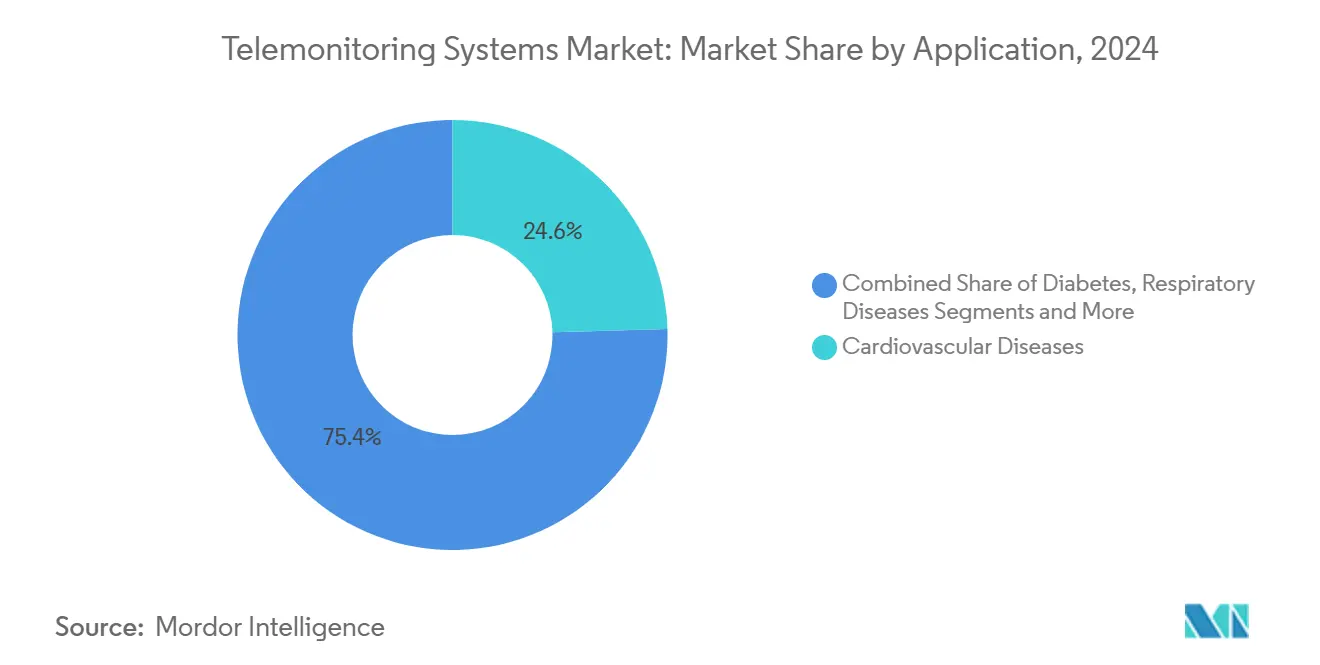
Note: Segment shares of all individual segments available upon report purchase
By End-User Setting: Home Care Transforms Healthcare Delivery
Hospitals and specialty clinics retained 43.21% of telemonitoring systems market share in 2024 by embedding RPM into established protocols and electronic records. Yet home-care settings post a 15.88% CAGR, reflecting patient preference for comfort and the CMS Acute Hospital Care at Home waiver’s cost-saving results. Telemonitoring systems industry alliances with home-health agencies are accelerating as value-based contracts reward readmission avoidance.
Long-term-care facilities adopt fall-detection wearables and smart beds to extend staff capacity, whereas ambulatory surgical centers use short-term RPM bundles to prevent post-discharge complications. The Toronto Grace program illustrates scalability, overseeing 16,000 clients with ambitions to reach 30,000, proving remote monitoring is viable at province-wide scale.
Geography Analysis
North America commanded 39.87% of telemonitoring systems market share in 2024 on the back of reimbursement leadership and mature provider networks. CMS data show 31,000 patients treated via Hospital-at-Home since 2020 with lower mortality and spending, reinforcing payor confidence in remote care. Mass General Brigham’s 70-bed capacity demonstrates how large systems leverage telemonitoring to free inpatient beds for higher acuity cases. Enterprise deals between Philips and leading health systems are translating into nationwide rollouts of AI-enabled dashboards.
Asia-Pacific is the fastest-growing territory with a 14.76% CAGR to 2030, supported by proactive digital-health policies. Japan’s 7.29% market expansion underscores how demographic pressure catalyzes technology uptake, whereas China’s 5G private networks create infrastructure readiness for always-on monitoring. Bibliometric analysis reveals China jumped from 10th to 6th in telemedicine publications post-pandemic, reflecting amplified innovation spending.
Europe posts steady growth anchored by the WHO Regional Digital Health Action Plan, with Norway’s AI-assisted teleradiology programs setting benchmarks for cross-border data-sharing. Yet reimbursement fragmentation slows deployment speed. The forthcoming European Health Data Space and HTA regulation aim to harmonize evaluation criteria, which could reduce launch timelines.
Elsewhere, Middle East, Africa, and South America remain nascent but promising. Pilot programs in the United Arab Emirates and Brazil demonstrate viability once regulatory guardrails and broadband build-outs advance.
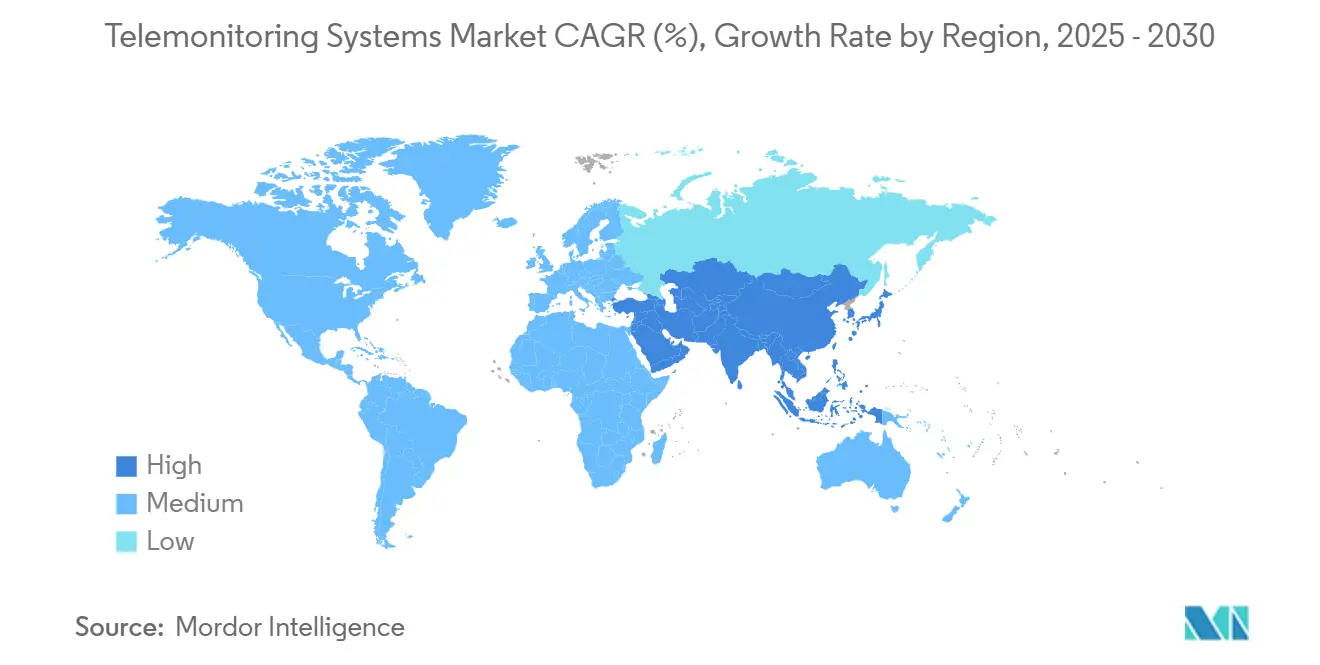
Competitive Landscape
The telemonitoring systems market shows moderate concentration. Philips pairs deep imaging heritage with acquisitions such as smartQare to offer end-to-end ecosystems. Abbott’s portfolio spans cardiac monitors and CGMs, enabling cross-selling and data pooling that strengthen algorithm performance. Boston Scientific differentiates with HeartLogic and Bluetooth-enabled implantables that feed cloud analytics.
Platform players such as Teladoc Health pursue inorganic growth, acquiring Catapult Health and UpLift to widen chronic-condition programs. GE HealthCare invests in AI labs and oncology-centric RPM, signaling a shift from modality sales to subscription analytics. Niche start-ups focus on workflow software and rural connectivity, aiming to license technology to the giants.
Competitive success now hinges on regulatory savvy, payer engagement, and data-science excellence more than on hardware innovation alone. Vendors with clinically validated algorithms, broad device portfolios, and integration APIs will retain pricing power.
Telemonitoring Systems Industry Leaders
-
Abbott Laboratories
-
Koninklijke Philips NV
-
GE Healthcare
-
Medtronics plc
-
Boston Scientific Corporation
- *Disclaimer: Major Players sorted in no particular order
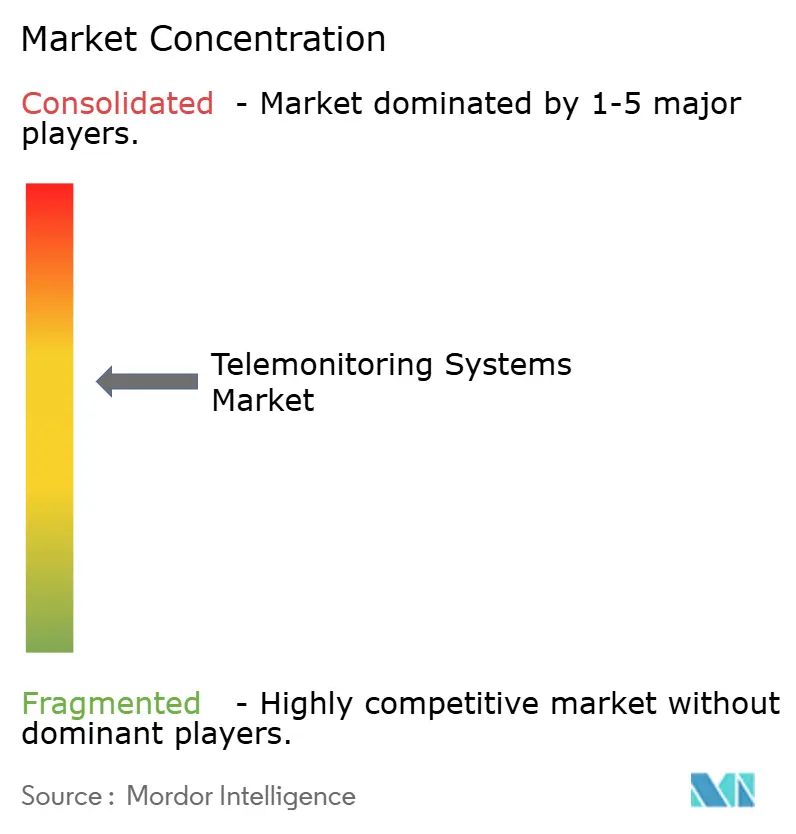
Recent Industry Developments
- February 2025: Philips and Mass General Brigham launched a collaboration to integrate live AI insights into continuous heart monitoring.
- February 2025: Teladoc Health acquired Catapult Health for USD 65 million to expand at-home testing and chronic-care enrollment.
- January 2025: Teladoc Health partnered with Amazon Health to extend cardiometabolic programs to more than 1 million members.
Research Methodology Framework and Report Scope
Market Definitions and Key Coverage
Telemonitoring systems are integrated device-plus-platform solutions that record clinical parameters, ranging from multi-lead ECG and capillary glucose to oximetry, blood pressure, and multiparameter bundles, and transmit them either continuously or at programmed intervals to a secure clinician dashboard. We size the market on the basis of gross revenue generated from the sale or lease of purpose-built hardware, embedded software licenses, and dedicated analytics platforms that enable remote physiological oversight across hospital, long-term care, and home settings in every major region.
Scope exclusion: the study omits generic teleconsultation services, over-the-counter fitness wearables, and legacy analogue alert buttons.
Segmentation Overview
- By Product Type
- COPD Telemonitoring Systems
- Glucose Level Telemonitoring Systems
- Cardiac Telemonitoring Systems
- Blood-Pressure Telemonitoring Systems
- Multi-parameter/Other Systems
- By Component
- Devices
- Software Platforms
- Services
- By Connectivity Technology
- Bluetooth / Low-Energy
- Cellular / NB-IoT
- Wi-Fi / WLAN
- Wired
- By Application / Condition
- Cardiovascular Diseases
- Diabetes
- Respiratory Diseases (e.g., COPD, Asthma)
- Other Chronic & Acute Conditions
- By End-User Setting
- Hospitals & Specialty Clinics
- Home-care Settings
- Long-term Care Facilities
- Ambulatory Surgical & Out-patient Centers
- By Geography
- North America
- United States
- Canada
- Mexico
- Europe
- Germany
- United Kingdom
- France
- Italy
- Spain
- Rest of Europe
- Asia-Pacific
- China
- Japan
- India
- Australia
- South Korea
- Rest of Asia-Pacific
- Middle East and Africa
- GCC
- South Africa
- Rest of Middle East and Africa
- South America
- Brazil
- Argentina
- Rest of South America
- North America
Detailed Research Methodology and Data Validation
Desk Research
Our team first collated publicly available data from tier-1 sources such as the WHO's Non-Communicable Disease statistics, the Centers for Medicare & Medicaid Services remote patient monitoring fee schedules, Eurostat hospital admission files, and trade flow data from UN Comtrade. Company 10-Ks, investor decks, and clinical trial registries supplemented unit shipment and ASP signals. We then accessed D&B Hoovers financials and Dow Jones Factiva news libraries to verify revenue splits and pipeline launches.
Additional context came from specialty associations, including the Heart Rhythm Society, International Diabetes Federation, and the Global Coalition on Aging, which provided prevalence baselines, technology adoption snapshots, and reimbursement trajectory notes. The desk research list is illustrative; many more sources informed data cleaning, assumption tests, and narrative checks.
Primary Research
Mordor analysts interviewed hospital telemetry managers, home health operators, payor coding specialists, and device engineers across North America, Europe, Asia-Pacific, and the GCC. These conversations clarified real-world penetration rates, device replacement cycles, and likely reimbursement shifts, helping us reconcile gray area assumptions flagged during secondary review.
Market-Sizing & Forecasting
A top-down prevalence to treated cohort model anchored each therapeutic pool (cardiac, diabetes, COPD, hypertension); results were corroborated with selective bottom-up supplier roll-ups from sampled unit shipments and blended ASPs. Key variables like connected cardiac monitor installed base, annual chronic disease incidence, RPM reimbursement claim volumes, home care admission growth, and average Bluetooth telemetry ASPs drove value calculations. We employed multivariate regression with lagged macro indicators (aging population ratio, broadband penetration, health expenditure per capita) to project adoption, while scenario analysis stress tested optimistic and conservative reimbursement pathways. Data gaps in low reporting countries were bridged by regional proxy ratios agreed during expert calls.
Data Validation & Update Cycle
Before release, outputs pass anomaly screening, senior analyst peer review, and a model versus external signal gap check. Reports refresh every twelve months, and an interim update triggers whenever material events, such as regulatory shifts, device recalls, and landmark reimbursement codes, move the baseline.
Why Mordor's Telemonitoring Systems Baseline commands reliability
Published numbers often diverge because firms pick dissimilar scopes, count service revenue differently, or refresh at uneven cadences.
Key gap drivers include service heavy valuations, inclusion of wider telehealth modules, single source ASP assumptions, and currency conversion cut-offs that Mordor's balanced device-plus-platform lens, mixed method validation, and annual refreshes mitigate.
Benchmark comparison
| Market Size | Anonymized source | Primary gap driver |
|---|---|---|
| USD 5.14 billion | Mordor Intelligence | - |
| USD 31.74 billion | Global Consultancy A | Counts all telemonitoring services and chronic care management fees, inflating value versus our device-plus-platform scope |
| USD 8.68 billion | Industry Publication B | Focuses on RPM devices only; applies uniform 18% CAGR without country level prevalence adjustment |
In sum, Mordor's disciplined scope selection, variable rich model, and multi-source validation deliver a transparent, decision ready baseline that clients can trace, question, and reproduce with confidence.
Key Questions Answered in the Report
1. What is the projected value of the telemonitoring systems market by 2030?
The market is forecast to reach USD 9.57 billion by 2030, growing at a 13.24% CAGR.
2. Which product segment currently leads the telemonitoring systems market?
Cardiac telemonitoring systems lead with 31.43% revenue share in 2024.
3. Why are software platforms the fastest-growing component?
Providers need integrated analytics and AI decision support, driving software to a 15.34% CAGR.
4. How does reimbursement influence market growth?
CMS’s expanded RPM and Advanced Primary Care Management codes create multiple payment paths, accelerating US adoption.
5. What geographic region is expanding the quickest?
Asia-Pacific is projected to grow at 14.76% CAGR, boosted by 5G rollouts and supportive digital-health policies.
Page last updated on:
